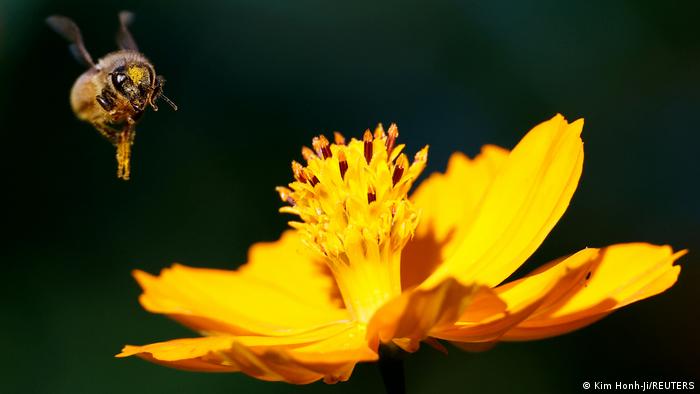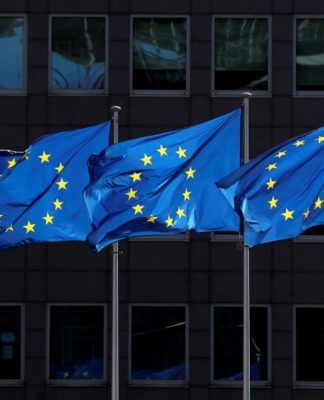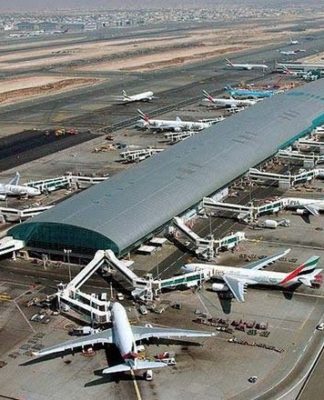ENVIRONMENT
How to help heat-stressed bees and protect global food supply
Plants struggle to produce nectar and pollen during heatwaves, limiting the pollinating power of bees or butterflies. Researchers are finding ways for agriculture to adjust to a hotter world.
A bee flies towards an open yellow flower
Heat stress is shifting the delicate balance between plants and pollinators but climate adaptation is still possible
As summer ends for some and spring blooms for others, bees and butterflies are doing their best to pollinate the flowers that become the food we eat. They, and a host of other animals and insects from bats to beetles and bees, play a vital role in ensuring our supermarket shelves are stocked with nutritious fruit and vegetables.
Meanwhile, plants too are doing their bit to offer these busy pollinators some “floral rewards,” meaning flowers filled with a lot of high-energy nectar and precious pollen.
But like us, plants and pollinators are feeling the extreme heat of hotter summers. Flowering crops from canola to blueberries are struggling to create the quality and quantity of nectar and pollen to attract bees, and therefore to reproduce.
And that’s a vicious cycle because vital pollinators might also battle to repopulate as they’re forced to forage longer for adequate nutrients.
While cutting fossil fuel use is the necessary long-term solution to extreme heat, a host of adaptation measures can help lessen the sting.
Keeping bees and crops happy in the heat
Crop shading is one strategy to regulate temperatures during the peak of summer. It has been shown to improve yields in flowering vegetable crops, implying that pollen production has been maintained.
Play Video3:55 min
Saving the right bees
Applying layers of mulch to the soil also helps retain water and reduce soil temperatures during extreme heat. The method has helped maintain pollen development in squash, for example, and the attendant health of squash bee populations.
Meanwhile, experts say it is better to limit fertilizer, and hence growth, during extreme heat so energy is directed instead at self-preservation — and providing quality nectar for bees.
Planting genetically diverse crops also helps plants evolve to become more climate resilient, according to researchers. This is an effective strategy for sustaining pollinator diversity, controlling pests and diseases and maintaining soil health and biodiversity.
An insect sits in a white flower
Plants affected by heat are struggling to produce enough pollen to go around
How does extreme heat alter nectar and pollen?
Around 80% of crop and wild-flowering plant species in the European Union are highly dependent on animal pollination. Some €3.7 billion ($3.8 billion) of the EU’s annual agricultural output is directly dependent on pollinators like bees.
“Temperature rise and water stress affect both the quantity and composition of floral resources in a bee-pollinated species,” said the authors of a 2021 study on how climate change is shifting bee-crop interactions.
Focused on the impact of heat and water stress on borage, or star flower, a herb grown widely across Europe, the study observed lower sugar concentration and amino acid content in the nectar but also an 80% reduction in nectar volume.
Less sugary nectar means fewer “flower rewards,” meaning pollinators like honeybees are more likely to give the plant a pass.
Bee reproduction is dependent on pollen
Meanwhile, decreased sugar quantity can also negatively impact the flight performance of bees, say the researchers.
Bees tend to favor sugary nectar over protein-rich pollen when foraging as it provides the carbohydrates and energy to fly, notes Jenna Walters, a Ph.D. candidate at Michigan State University, who is studying bee-plant interactions.
Infografik Aussterbende Insektenarten EN
Pollen is not only used to fertilize plants, it’s also used to feed bee larvae, which is one of the key problems of heat-stressed plants producing less of it.
Limited pollen resources could not only mean fewer offspring; it can also cause an imbalance in the number of males and females that are born, according to Walters.
“When pollen resources are low, there can be a higher number of male brood produced than female brood,” she said.
Since females are the “primary pollinators” of plants and crops, subsequent generations are likely to dwindle. Bee population numbers also stand to be affected “as fewer females are present to mate and lay eggs,” Walters said. As female “pollination services” are reduced, the cycle of declining crop yields will continue.
Creating heat-resilient agricultural systems
As temperatures continue to rise, there is an urgent need to develop heat-resistant crops and strains of pollen to keep bees busy.
Some flowering plants are simply more resistant to heat than others, found one study showing how nectar content is less impacted in specific wildflowers suffering water and temperature stress.
Wildflowers that are more climate resilient can then be planted in the vicinity of crops to attract pollinators, researchers said, having demonstrated how crop yields can rise when bordering wildflowers promote bee visitation.
Meanwhile, scientists are also developing heat-resistant strains of pollen and stress-tolerant plant genes that maintain reproductive health.
For Walters, better understanding of the impact of heat stress on crop-pollinator interactions is fundamental to creating what she and her co-authors call the “heat-resilient agricultural systems” of the future.
Two butterflies sucking nectar from orange flowers
WHAT HAVE INSECTS EVER DONE FOR US?
Planet of the insects
From pretty butterflies to pesky mosquitoes — insects are among the most diverse and dominant groups on earth. Nearly 1 million species are known to exist and there are likely many more to be discovered. According to a UN biodiversity study, up to 40% of insects species are threatened with extinction in some parts of the world. Many people do not realize that their loss would be keenly felt.
12345678
Edited by: Tamsin Walker and Jennifer Collins
DW RECOMMENDS
Bees have a secret survival weapon that might surprise you
The humble honeybee can control temperature in astounding ways — from keeping the hive cool during heat waves to cooking their enemies alive.
Europe set for record wildfire destruction in 2022
Nearly 660,000 hectares of European land have already been destroyed by fires this year, according to EU data. The scale of the destruction this year would be the worst since records began in 2006.
Pollinators under threat
More and more pollinators around the world are vanishing. That’s a threat to biodiversity as well as our food security. What can we do to protect bees, flies, butterflies and other pollinating creatures?
Ukraine war worsens food insecurity worldwide — report
Food prices soared beyond the reach of many, even before Russia’s war in Ukraine choked grain supplies, a new report says. The effects of climate change, COVID-19 and armed conflicts drove up the cost of basic goods.
WWW LINKS
Progress in the implementation of the EU Pollinators Initiative 2021
Study: Heat of the moment: extreme heat poses a risk to bee–plant interactions and crop yields
Study: Hand pollination of crops is of major importance
AUDIOS AND VIDEOS ON THE TOPIC
Bayer and the Bees
Bats – animals with superpowers
Slovenia: Home of the Carniolan honeybee
Doing Your Bit: Saving bees with innovative hives
Date 19.09.2022
Author Stuart Braun
Related Subjects COP 26: Everything you need to know, Climate change
Keywords bees, pollinators, pollen, nectar, heat stress, climate change, crops
Feedback: Send us your feedback.
Print Print this page
Permalink https://p.dw.com/p/4FnWn

























